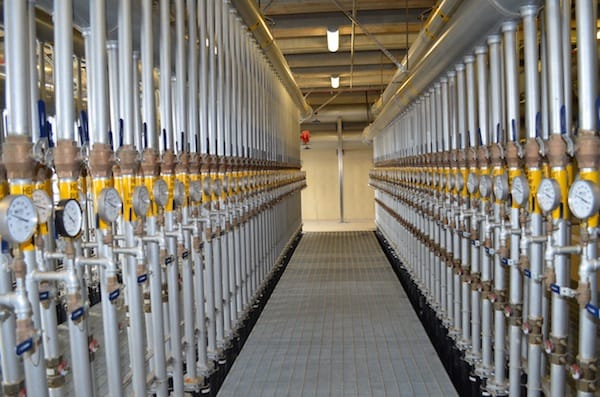Advocate Sherman Hospital in Elgin, Illinois, adhered to a geothermal heat pump design, a concept was introduced by engineer KJWW, who recommended that hospital management visit Great River Medical Center in West Burlington, Iowa, to view such a system in use in a hospital environment. This facility has one of the lowest operating costs of any healthcare system in the U.S. It is believed that the HVAC system at that site saves over $1 million compared to a conventional plant.

According to Ray Diehl, manager of facilities, the hospital board and management were impressed with the geothermal system and its potential to reliably provide building comfort at a operating cost far less than conventional systems. Reported by Diehl, although electricity use went up on average 15% per year, natural gas savings were down 80% and water usage was down 72%, primarily due to cooling tower elimination.
This solution was developed for the Sherman Hospital project, using an excavated 15-acre pond adjacent to the hospital as a heat source/sink for the circulating fluid that serves the hospital heat pumps. The system is the largest hospital geothermal system in the U.S., and the pond is the largest heat exchange pond in the world. The system includes 171 submerged loops of one-inch high-density polyethylene (HPDE) pipe. In total, the loops contain 152 miles of heat exchange pipe. The loops are supported on cribs on the bottom of the 18-foot deep flat-bottomed pond. According to Diehl, the geothermal had a 6.1-year payback with the lake extension and a 3.9-year payback with significant federal and state grants.

The working fluid for the system is an 80/20 solution of water and methyl alcohol, which is intended to prevent freezing if a loop is taken out of circulating service. Each of the 171 loops is independently valved in the impressive “manifold room.” Here the loops empty into circulating fluid manifolds, which serve the building’s heat pumps.
Of the 255 patient rooms, 224 are served with individual water-to-air heat pumps that supply both heating and cooling. The heat pumps are vertical units and are located in an enclosure with access from the hallway outside the patient room. There units are Mammoth Model NVintage and are typically ¾ ton (9,000 Btuh) capacity.
These units are designed for high efficiency operation and feature quick disconnects for circulating water, electrical and inlet and outlet air. In the event an individual unit requires service, it can be quickly changed out from the hallway without disturbing the patient. Each room has a ceiling supply diffuser and a return air inlet. The conditioned air supplied to each room is blended with ventilation air. In a clever design twist, the elevated unit enclosure creates space for a floor level half-closet in the patient room, suitable for linen storage and other purposes.
In addition to the heat pumps serving patient rooms, another 540 horizontal water-to-air units are located throughout the hospital and are located in ceiling spaces in corridors, nursing centers and other areas. The combined geothermal system provides more than 75% of the heating and cooling for the building. Although it is not the primary system for the emergency room and critical care areas, the heat pump system does provide reheat for the units that serve these areas. The hospital also has two large fire-tube boilers to provide steam for food service, domestic hot water, sterilizer supply and other
purposes. These boilers can also provide supplementary steam for space heating.

Another major element of the hospital comfort system is 18 Governair RTU custom rooftop vestibules. According to David Harris from Governair, “We can design equipment to meet the customer’s specific requirements both in capacity and unit configuration. Every component is carefully picked to meet or exceed the design criteria; this is not a modified standard package unit.”
These all-weather enclosures contain a total of 66 dual-compressor water-towater Mammoth heat pumps rated at 20 tons each. These units operate on the
same circulating fluid as the water-to air units. Individual enclosures have two, four, six or eight heat pumps. According to Harris, everything but the piping in the units was done at the factory. This includes air handlers, piping access, DDC controls. Additionally, 11 of the rooftop enclosures also house heat wheels, which salvage heat from building exhaust streams and return it to the circulating fluid. The heat wheels are important contributors to overall building efficiency.
“If this was an office, would we do geothermal?” asks Diehl semi-rhetorically. “Yes, it would work even better.”






Join the conversation: